Clasp dentures with clasps
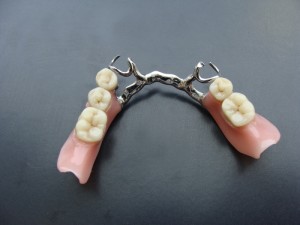
Clasp prosthesis with clasps is one of the most common types of removable dentures.
Clasps are made of metal and are hooks that are necessary to fix the structure in the patient's oral cavity. They, in addition to the retaining function, also perform the supporting function.
The clasp evenly distributes the chewing load between the teeth and gums. Clasp hooks clasp an abutment tooth in the area of its neck.
To fix the prosthesis to the teeth there is no need to turn them.
Clasp prosthesis clam comprises:
- arcs;
- basis with artificial teeth;
- support - holding element.
The most common supporting - retaining element of the clasp structure is the clasp (metal hook).
It can be made of stainless steel, metal alloys based on gold. For each patient, an appropriate form of clasp is selected individually.
The arc and clasp are part of the cast framework of the clasp prosthesis on which the plastic bed with artificial teeth is located. Cast frame is made of dental alloy and easily withstands significant chewing loads.
There are several types of clasp mounts:
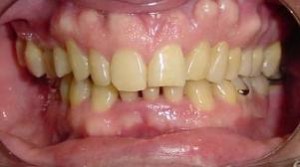
- Holding the clasp. When loaded, they settle and transmit pressure to the mucous membrane of the oral cavity.
- Support hooks. The pressure that occurs during eating, talking, squeezing and unclenching the teeth on the supporting teeth and partially on the oral mucosa is transmitted.
- Support - holding clasp.
The structure of the support - holding clasp:
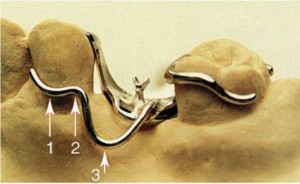
- The body of the clasp is the main fixed part located in the upper part of the tooth.
- Clammer's shoulders are the elements adjacent to the surface of the abutment tooth in front and behind. The retention and stationary parts of the shoulder are distinguished.
- The occlusal pad prevents the clasp structure from being immersed in the oral mucosa and transfers a vertical load to the abutment teeth.
- The process of the clasp is a section of the body of the clasp that goes into the basis of the structure.
Distinguish clasp constructions:
- In shape - flat, ribbon, semicircular, round.
- By grasping a tooth or dentition - one-armed, two-armed, ring-shaped, single-link, double.
- Depending on the purpose of application - holding, supporting and supporting - holding.
- According to the manufacturing method and material - cast (they have greatly reduced spring properties) and bent (made from special blanks).
Clasp requirements for clasp structures
- Ensuring fixation of the prosthesis.
- Chewing pressure transmission along the axis of the tooth.
- Rational distribution of chewing pressure between the oral mucosa and teeth.
- No effect on the tooth of the clasp at rest.
- No load on the supporting tooth apparatus.
- In case of periodontitis, the multi-link hook should perform a locking function.
Indications
Clasp prostheses with clasp fixation recommended in the following cases:
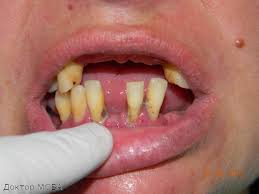
- In the presence of an end defect of teeth.
- Lack of one or more teeth.
- For splinting with periodontitis or periodontal disease.
- The presence of a deep bite and bruxism, if other methods of prosthetics are contraindicated.
- With orthopedic treatment in case of increased tooth abrasion.
- Atrophic process of the alveolar bone, if plate-like construction is not possible.
- The presence of a flat palate and pronounced maxillary tubercles.
- Diabetes mellitus and other diseases in which weakness of the capillaries of the oral mucosa is expressed.
Contraindications
The use of removable tooth designs it is possible in almost all patients, since there are no contraindications to this method of prosthetics.
Unfortunately, clasp prosthetics has one significant requirement: the patient must have several abutments, to which the structure will be attached.
There may be temporary contraindications to clasp prosthetics with clasp fixation:
- Acute diseases of the oral cavity.
- During and after radiation therapy.
- Failure to comply with oral hygiene.
- State of pregnancy.
Benefits
Clasp prosthetics on clasps have the advantages:
- Comfort and functionality.
- Due to the even distribution of the masticatory load, the development of pathological changes in the oral cavity is slowed down.
- The taste and temperature sensitivity is not violated.
- No effect on diction.
- Quickly getting used to the design.
- Ease of use and care.
- Able to strengthen loose teeth.
- Securely fixed.
- Low cost in comparison with other types of removable prosthetics.
disadvantages
Cons of clasp prostheses:
- Lack of aesthetics, because in some cases, metal hooks attached to the abutment teeth may be visible.
- A long period of adaptation and rubbing of the oral mucosa with metal hooks during meals.
- The need for hygienic cleaning of the prosthesis.
- Cost is higher than plate designs.
Manufacture
Manufacturing stepsClasp prosthesis with clasps:
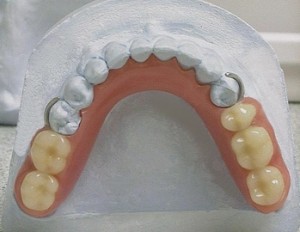
- Examination of the patient. Preparing teeth for prosthetics.
- Grinding teeth under crowns. Hooks will be attached to them and the structure will be fixed.
- Taking impressions from the jaws of the patient.
- Color determination of artificial teeth.
- Protection of prepared teeth with temporary crowns.
- The manufacture of crowns and arcs of clasp structures in the laboratory.
- Fixation of crowns on teeth.
- Fitting the skeleton of the clasp prosthesis.
- Final laboratory fabrication of the structure.
- Delivery of a finished denture to the patient.
Lab construction
- Based on the impressions made of gypsum, the model is cast.
- Wax bases with occlusal rollers are made.
- Drawing a picture of the frame on the gypsum model.
- Duplication of the gypsum model.
- Simulation of the skeleton of the clasp structure.
- Frame casting, polishing, grinding.
- Metal frame fitting on the model.
- Checking the metal frame in the patient's oral cavity.
- Modeling the basis of wax, the selection and installation of teeth on the structure.
- Checking the arch prosthesis in the oral cavity.
- Replacing the wax part with plastic, grinding and polishing the prosthesis.
- Fitting and applying an arch prosthesis.
- Recommendations for the use and care of the finished structure.
The manufacturing time of the clasp prosthesis on the clasps lasts from one to two months.
Video: “Making a clasp prosthesis”
Care
Artificial teeth, like natural ones, require careful hygienic care.
- Clasp prosthesis no need to remove at night.
- The dental structure must be removed twice a day for oral hygiene and for cleansing the prosthesis of plaque and food particles clogged in it. For washing and cleaning the structure using a conventional toothbrush and toothpaste.
- After eating, rinse your mouth with water.
With proper care of the prosthesis, its service life will be up to 5 years.
Reviews
When choosing a clasp design, it makes sense to be guided by the reviews of people who already use such prostheses. Clasp dental prosthetics is characterized by reviews on the following design characteristics: ease of use, durability and reliability of the prosthesis and the duration of its use.
Reviews of clasp prostheses on clasps:
- I had a negative experience associated with the installation of a plate prosthesis, and therefore, I did not trust the process of removable prosthetics. I got clasp dentures on the clasps. They are visible when I smile, but the plus of them is that they are practically not felt.
- Previously, he wore an acrylic prosthesis, which greatly interfered with food. With a clasp prosthesis with clasp fixation I feel more comfortable. But he is very noticeable to others.
- I can’t smile, I'm afraid to shock others! Very dissatisfied with clasp prosthesis with clasps. It took some time to get used to it.
- She installed a clasp prosthesis with a clasp fixation. I was very afraid that it would be visible to outsiders, it would interfere with food and conversation. They installed the prosthesis without pain, the hooks are almost invisible, very comfortable to wear and do not fall out.
- The doctor said that the best way for me is to use a clasp prosthesis with clasps. It does not look like a “false jaw” at all, it is excellent in holding. So it is, the prosthesis holds great, does not worsen speech, does not interfere at all. I have been using it for two years, the prosthesis does not wear out and looks good. And it was not expensive at all.
Prices
The cost of a clasp prosthesis on clasps depends on the complexity of manufacturing the structure in various clinical situations.
The price may include: consultation and dental treatment, impression taking from the jaw. The price of the clasp structure is affected by the choice of the type of fixation to the abutment teeth.
Clasp prostheses with clasp fixation are much cheaper than, for example, on locks.
| Type of clasp prosthesis | Price, rub.) |
| Simple prosthesis with clasps | 15000 |
| Simple locking prosthesis | 45000 |
| Complicated prosthesis with clasps | 21000 |
| One-sided lock design | 40000 |
| Clamping splinting | 19000 |
Before and after photos
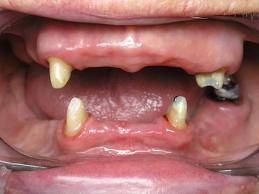 |
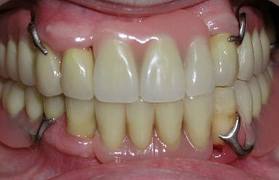 |
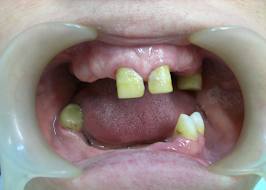 |
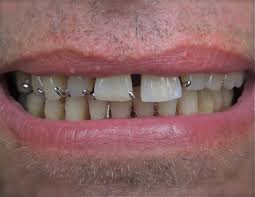 |
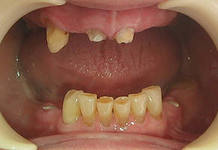 |
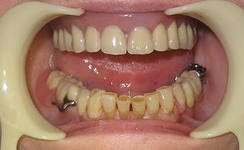 |